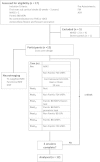Contralesional hemisphere control of the proximal paretic upper limb following stroke
- PMID: 22139791
- PMCID: PMC4705341
- DOI: 10.1093/cercor/bhr344
Contralesional hemisphere control of the proximal paretic upper limb following stroke
Abstract
Cathodal transcranial direct current stimulation (c-tDCS) can reduce excitability of neurons in primary motor cortex (M1) and may facilitate motor recovery after stroke. However, little is known about the neurophysiological effects of tDCS on proximal upper limb function. We hypothesized that suppression of contralesional M1 (cM1) excitability would produce neurophysiological effects that depended on the severity of upper limb impairment. Twelve patients with varying upper limb impairment after subcortical stroke were assessed on clinical scales of upper limb spasticity, impairment, and function. Magnetic resonance imaging was used to determine lesion size and fractional anisotropy (FA) within the posterior limbs of the internal capsules indicative of corticospinal tract integrity. Excitability within paretic M1 biceps brachii representation was determined from motor-evoked potentials during selective isometric tasks, after cM1 sham stimulation and after c-tDCS. These neurophysiological data indicate that c-tDCS improved selective proximal upper limb control for mildly impaired patients and worsened it for moderate to severely impaired patients. The direction of the neurophysiological after effects of c-tDCS was strongly related to upper limb spasticity, impairment, function, and FA asymmetry between the posterior limbs of the internal capsules. These results indicate systematic variation of cM1 for proximal upper limb control after stroke and that suppression of cM1 excitability is not a "one size fits all" approach.
Figures





References
-
- Ackerley SJ, Stinear CM, Barber PA, Byblow WD. Combining theta burst stimulation with training after subcortical stroke. Stroke. 2010;41:1568–1572. - PubMed
-
- Alagona G, Delvaux V, Gerard P, De Pasqua V, Pennisi G, Delwaide PJ, Nicoletti F, Maertens de Noordhout A. Ipsilateral motor responses to focal transcranial magnetic stimulation in healthy subjects and acute-stroke patients. Stroke. 2001;32:1304–1309. - PubMed
-
- Boggio PS, Nunes A, Rigonatti SP, Nitsche MA, Pascual-Leone A, Fregni F. Repeated sessions of noninvasive brain DC stimulation is associated with motor function improvement in stroke patients. Restor Neurol Neurosci. 2007;25:123–129. - PubMed
Publication types
MeSH terms
LinkOut - more resources
Full Text Sources
Medical

